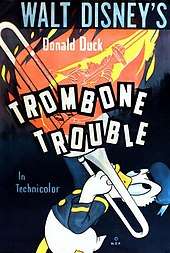Trombone Trouble
Trombone Trouble is a Walt Disney cartoon that was released on February 18, 1944.[1] It is the only Donald Duck cartoon where Roman/Greek gods play a role.
| Trombone Trouble | |
|---|---|
 Theatrical release poster | |
| Directed by | Jack King |
| Produced by | Walt Disney |
| Story by | Jack Hannah Carl Barks |
| Starring | Clarence Nash Billy Bletcher John McLeish |
| Music by | Paul J Smith |
| Animation by | Ed Love Paul Allen Ray Patterson Andy Engman |
| Color process | Technicolor |
Production company | Walt Disney Productions |
| Distributed by | RKO Radio Pictures |
Release date | 18 February 1944 (USA) |
Running time | 7:03 minutes |
| Language | English |
Synopsis
Pete is cacophonically playing his trombone through the night. The gods Jupiter and Vulcan (who look like ducks similar to Donald) are woken by Pete's noise and decide to think of some way to stop this. Donald has a similar issue. He can't sleep with Pete's noise. He goes to Pete's house, and Pete responds by blowing through the trombone as hard as he can right in Donald's face, sending Donald back into his house into a wall. Jupiter and Vulcan notice Donald wanting to stop the noise, so Jupiter decides to give him some of his power so he can get rid of Pete. Donald fires lightning bolts from his hands, makes his hands electric, and develops godlike strength and succeeds in getting rid of Pete. Jupiter and Vulcan think that their troubles are now over, and go back to sleep on their cloud. Donald notices Pete's trombone and has the desire to play it. Jupiter and Vulcan awake to see that the one whom they helped get rid of Pete is now playing the trombone himself and they collapse from the cloud with exasperation.
Voice actors
- Goofy: Pinto Colvig
- Pete: Billy Bletcher
- Jupiter and Vulcan: John McLeish[2]
References
- Lenburg, Jeff (1999). The Encyclopedia of Animated Cartoons. Checkmark Books. pp. 74–76. ISBN 0-8160-3831-7. Retrieved 6 June 2020.
- Hischak, Thomas S. (2011). Disney Voice Actors: A Biographical Dictionary. McFarland & Company. p. 263. ISBN 978-0786462711. Retrieved 15 February 2020.